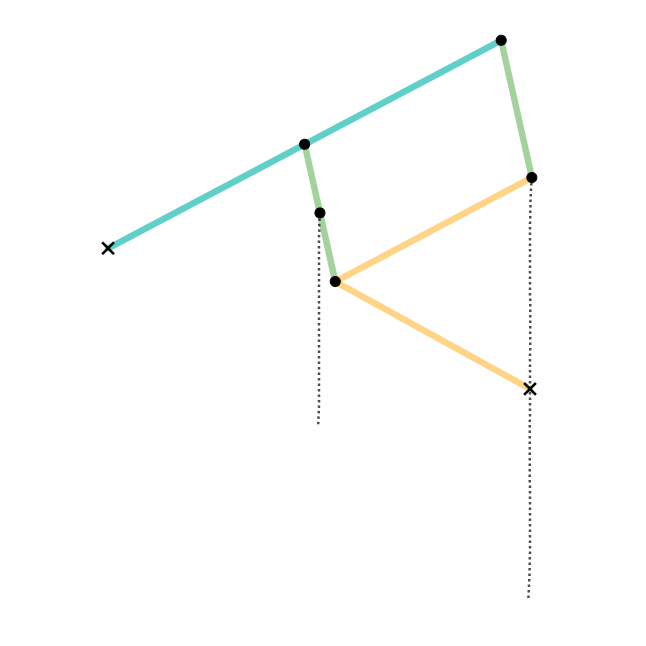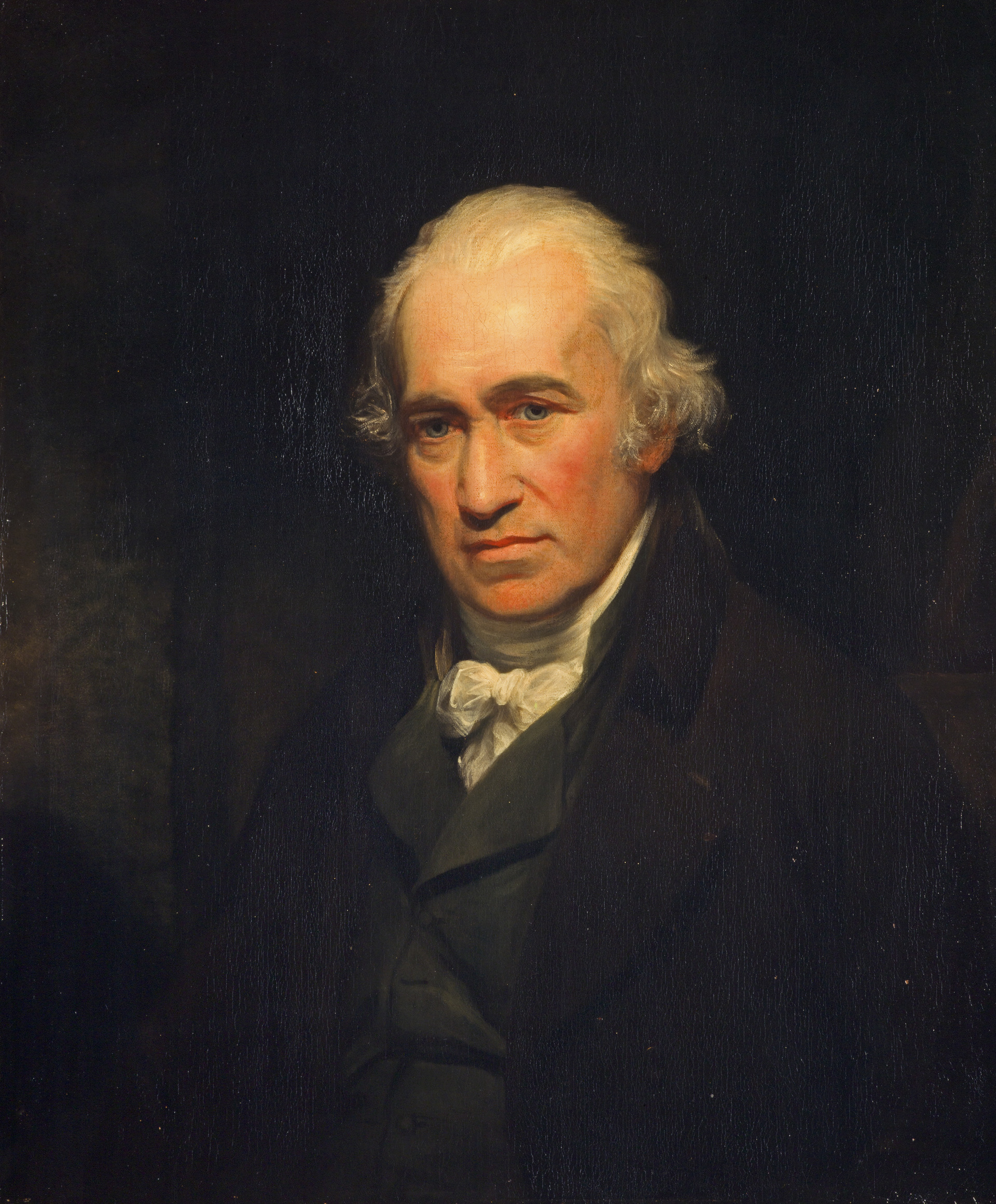|
Chebyshev Linkage
In kinematics, Chebyshev's linkage is a four-bar linkage that converts rotational motion to approximate linear motion. It was invented by the 19th-century mathematician Pafnuty Chebyshev, who studied theoretical problems in kinematic Mechanism (engineering), mechanisms. One of the problems was the construction of a linkage that converts a rotary motion into an approximate straight-line motion (a straight line mechanism). This was also studied by James Watt in his improvements to the steam engine, which resulted in Watt's linkage. – Cross link straight-line mechanism Equations of motion The motion of the linkage can be constrained to an input angle that may be changed through velocities, forces, etc. The input angles can be either link ''L''2 with the horizontal or link ''L ...[...More Info...] [...Related Items...] OR: [Wikipedia] [Google] [Baidu] |
Watt's Linkage
A Watt's linkage is a type of mechanical linkage invented by James Watt in which the central moving point of the linkage is constrained to travel a nearly straight path. Watt's described the linkage in his patent specification of 1784 for the Watt steam engine. Today it is used in automobile suspensions, where it is key to a suspension's kinematics, i.e., its motion properties, constraining the vehicle axle's movement to nearly vertical travel while also limiting horizontal motion. Description Watt's linkage consists of three bars bolted together in a chain. The chain of bars consists of two end bars and a middle bar. The middle bar is bolted at each of its ends to one of the ends of each outer bar. The two outer bars are of equal length, and are longer than the middle bar. The three bars can pivot around the two bolts. The outer endpoints of the long bars are fixed in place relative to each other, but otherwise the three bars are free to pivot around the two joints where t ... [...More Info...] [...Related Items...] OR: [Wikipedia] [Google] [Baidu] |
Linkages (mechanical)
Linkage may refer to: * ''Linkage'' (album), by J-pop singer Mami Kawada, released in 2010 * Linkage (graph theory), the maximum min-degree of any of its subgraphs * Linkage (horse), an American Thoroughbred racehorse * Linkage (hierarchical clustering), The linkage criterion determines the distance between sets of observations as a function of the pairwise distances between observations *Linkage (linguistics), a set of languages descended from a former dialect continuum *Linkage (mechanical), assemblies of links designed to manage forces and movement *Linkage (policy), a Cold War policy of the United States of America towards the Soviet Union and Communist China * Linkage (software), a concept in computer programming *Genetic linkage, the tendency of certain genes to be inherited together *Glycosidic linkage, a type of covalent bond that joins a carbohydrate (sugar) molecule to another chemical group * Flux linkage, the total flux passing through a surface formed by a closed conduc ... [...More Info...] [...Related Items...] OR: [Wikipedia] [Google] [Baidu] |
Straight Line Mechanism
A straight-line mechanism is a mechanism that converts any type of rotary or angular motion to perfect or near-perfect straight-line motion, or ''vice versa''. Straight-line motion is linear motion of definite length or "stroke", every forward stroke being followed by a return stroke, giving reciprocating motion. The first such mechanism, patented in 1784 by James Watt, produced approximate straight-line motion, referred to by Watt as parallel motion. Straight-line mechanisms are used in a variety of applications, such as engines, vehicle suspensions, walking robots, and rover wheels. History In the late eighteenth century, before the development of the planer and the milling machine, it was extremely difficult to machine straight, flat surfaces. During that era, much thought was given to the problem of attaining a straight-line motion, as this would allow the flat surfaces to be machined. To find a solution to the problem, the first straight-line mechanism was develop ... [...More Info...] [...Related Items...] OR: [Wikipedia] [Google] [Baidu] |
Four-bar Linkage
In the study of Mechanism (engineering), mechanisms, a four-bar linkage, also called a four-bar, is the simplest closed-Kinematic chain, chain movable linkage (mechanical), linkage. It consists of four Rigid body, bodies, called ''bars'' or ''links'', connected in a loop by four Kinematic pair, joints. Generally, the joints are configured so the links move in parallel planes, and the assembly is called a ''planar four-bar linkage''. Spherical and spatial four-bar linkages also exist and are used in practice. Planar four-bar linkage Planar four-bar linkages are constructed from four links connected in a loop by four one-degrees of freedom (mechanics), degree-of-freedom joints. A joint may be either a revolute joint – also known as a pin joint or hinged joint – denoted by R, or a prismatic joint – also known as a sliding pair – denoted by P. A link that is fixed in place relative to the viewer is called a ''ground link.'' A link connecting to the ground by a revolute joint ... [...More Info...] [...Related Items...] OR: [Wikipedia] [Google] [Baidu] |
Cognate Linkage
In kinematics, cognate linkages are linkages that ensure the same coupler curve geometry or input-output relationship, while being dimensionally dissimilar. In case of four-bar linkage coupler cognates, the Roberts–Chebyshev Theorem, after Samuel Roberts and Pafnuty Chebyshev, Retrieved 2012-10-12 states that each coupler curve can be generated by three different four-bar linkages. These four-bar linkages can be constructed using similar triangles and parallelograms, and the Cayley diagram (named after ). Overconstrained mechanism ... [...More Info...] [...Related Items...] OR: [Wikipedia] [Google] [Baidu] |
Chebyshev Lambda Linkage
In kinematics, the Chebyshev Lambda Linkage is a four-bar linkage that converts rotational motion to approximate straight-line motion with approximate constant velocity. It is so-named because it looks like a lowercase Greek letter lambda (λ). The precise design trades off straightness, lack of acceleration, and the proportion of the driving rotation that is spent in the linear portion of the full curve. The example to the right spends over half of the cycle in the near-straight portion. The coupler (link 3) point stays within 1% positional tolerance while intersecting the ideal straight line 6 times. The linkage was first shown in Paris on the Exposition Universelle (1878) as "The Plantigrade Machine". The Chebyshev Lambda Linkage is a cognate linkage of the Chebyshev linkage. The Chebyshev Lambda Linkage is used in vehicle suspension mechanisms, walking robots, and rover wheel mechanisms. In 2004, a study completed as a Master of Science Thesis at Izmir Institute of Technol ... [...More Info...] [...Related Items...] OR: [Wikipedia] [Google] [Baidu] |
Level Luffing Crane
A level-luffing crane is a crane mechanism where the hook remains at the same level while luffing: moving the jib up and down, so as to move the hook inwards and outwards relative to the base. Usually the description is only applied to those with a luffing jib that have some ''additional'' mechanism applied to keep the hook level when luffing. Level-luffing is most important when careful movement of a load near ground level is required, such as in construction or shipbuilding. This partially explains the popularity of fixed horizontal jibs in these fields. Toplis cable luffing An early form of level-luffing gear was the "Toplis" design, invented by a Stothert & Pitt engineer in 1914. The crane jibs luffs as for a conventional crane, with the end of the jib rising and falling. The crane's hook is kept level by automatically paying out enough extra cable to compensate for this. This is also a purely mechanical linkage, arranged by the reeving of the hoist cables to the jib ... [...More Info...] [...Related Items...] OR: [Wikipedia] [Google] [Baidu] |
Steam Engine
A steam engine is a heat engine that performs Work (physics), mechanical work using steam as its working fluid. The steam engine uses the force produced by steam pressure to push a piston back and forth inside a Cylinder (locomotive), cylinder. This pushing force can be transformed by a connecting rod and Crank (mechanism), crank into rotational force for work. The term "steam engine" is most commonly applied to reciprocating engines as just described, although some authorities have also referred to the steam turbine and devices such as Hero's aeolipile as "steam engines". The essential feature of steam engines is that they are external combustion engines, where the working fluid is separated from the combustion products. The ideal thermodynamic cycle used to analyze this process is called the Rankine cycle. In general usage, the term ''steam engine'' can refer to either complete steam plants (including Boiler (power generation), boilers etc.), such as railway steam locomot ... [...More Info...] [...Related Items...] OR: [Wikipedia] [Google] [Baidu] |
Chebyshev Linkage Limit Of Input L2
Pafnuty Lvovich Chebyshev ( rus, Пафну́тий Льво́вич Чебышёв, p=pɐfˈnutʲɪj ˈlʲvovʲɪtɕ tɕɪbɨˈʂof) ( – ) was a Russian mathematician and considered to be the founding father of Russian mathematics. Chebyshev is known for his fundamental contributions to the fields of probability, statistics, mechanics, and number theory. A number of important mathematical concepts are named after him, including the Chebyshev inequality (which can be used to prove the weak law of large numbers), the Bertrand–Chebyshev theorem, Chebyshev polynomials, Chebyshev linkage, and Chebyshev bias. Transcription The surname Chebyshev has been transliterated in several different ways, like Tchebichef, Tchebychev, Tchebycheff, Tschebyschev, Tschebyschef, Tschebyscheff, Čebyčev, Čebyšev, Chebysheff, Chebychov, Chebyshov (according to native Russian speakers, this one provides the closest pronunciation in English to the correct pronunciation in old Russian), an ... [...More Info...] [...Related Items...] OR: [Wikipedia] [Google] [Baidu] |
James Watt
James Watt (; 30 January 1736 (19 January 1736 OS) – 25 August 1819) was a Scottish inventor, mechanical engineer, and chemist who improved on Thomas Newcomen's 1712 Newcomen steam engine with his Watt steam engine in 1776, which was fundamental to the changes brought by the Industrial Revolution in both his native Great Britain and the rest of the world. While working as an instrument maker at the University of Glasgow, Watt became interested in the technology of steam engines. At the time engineers such as John Smeaton were aware of the inefficiencies of Newcomen's engine and aimed to improve it. Watt's insight was to realise that contemporary engine designs wasted a great deal of energy by repeatedly cooling and reheating the cylinder. Watt introduced a design enhancement, the separate condenser, which avoided this waste of energy and radically improved the power, efficiency, and cost-effectiveness of steam engines. Eventually, he adapted his engine to produce rot ... [...More Info...] [...Related Items...] OR: [Wikipedia] [Google] [Baidu] |








